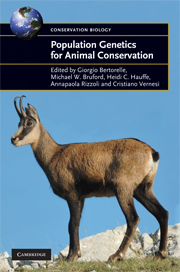Book contents
- Frontmatter
- Epigraph
- Contents
- List of contributors
- Foreword
- Acknowledgements
- 1 Introduction
- Statistical approaches, data analysis and inference
- 2 Statistical methods for identifying hybrids and groups
- 3 How to use MIGRATE or why are Markov chain Monte Carlo programs difficult to use?
- 4 Nested clade phylogeographic analysis for conservation genetics
- 5 A comparison of methods for constructing evolutionary networks from intraspecific DNA sequences
- Molecular approaches and applications
- From genetic data to practical management: issues and case studies
- Future directions in conservation genetics
- Software index
- Species index (common name)
- Species index (Latin name)
- Subject index
4 - Nested clade phylogeographic analysis for conservation genetics
from Statistical approaches, data analysis and inference
Published online by Cambridge University Press: 05 July 2015
- Frontmatter
- Epigraph
- Contents
- List of contributors
- Foreword
- Acknowledgements
- 1 Introduction
- Statistical approaches, data analysis and inference
- 2 Statistical methods for identifying hybrids and groups
- 3 How to use MIGRATE or why are Markov chain Monte Carlo programs difficult to use?
- 4 Nested clade phylogeographic analysis for conservation genetics
- 5 A comparison of methods for constructing evolutionary networks from intraspecific DNA sequences
- Molecular approaches and applications
- From genetic data to practical management: issues and case studies
- Future directions in conservation genetics
- Software index
- Species index (common name)
- Species index (Latin name)
- Subject index
Summary
INTRODUCTION
Genetic sequence data have become widely used in evaluating the unique relationship between geography and evolutionary history for conservation of species. Traditional methods, such as bifurcating trees and Wright's F-statistics, often fall short in detailing past and contemporary events and contribute little intraspecific information (Posada and Crandall 2001; Pearse and Crandall 2004). Phylogenetic techniques, when applied in lower level systematic studies, show poor resolution, often resulting in polytomies and ambiguous connections (Crandall et al. 1994). This is particularly the case when species have recently diverged or have complicated metapopulation structure, in which case, bifurcating trees do not have the ability to accurately depict their evolutionary history (Posada and Crandall 2001). Despite this lack of resolution, broad geographic patterns can still be elucidated for older taxa using phylogenetic approaches. The field of phylogeography began by overlaying phylogenies onto geography and making broad inferences about evolutionary histories of species and populations (Avise 1989). This approach, however, does not provide the opportunity to (1) statistically test the null hypothesis of no geographic association between populations, (2) test whether samples (number of individuals and collection localities) are sufficient, or (3) infer historical and contemporary processes and patterns that dictate current genetic variation (Carbone and Kohn 2004). However, approaches such as Nested Clade Analysis (NCA: Templeton et al. 1995), also known as Nested Clade Phylogeographic Analysis or NCPA (Templeton 2004), provide a statistical framework in which to test hypotheses about historical events and current population structure within species.
Indeed, conservation of a species is highly dependent on understanding the processes and the patterns that gave rise to the current phylogeographic composition of each unique taxon. The NCPA approach also has important applications to species delimitation and diagnosis, as it can be used to test for exchangeability and genealogical ‘exclusivity’ (Crandall et al. 2000). In this chapter, we detail the methodology of the NCPA of haplotype trees in phylogeographic studies and its application to a wide range of issues in conservation biology.
- Type
- Chapter
- Information
- Population Genetics for Animal Conservation , pp. 80 - 103Publisher: Cambridge University PressPrint publication year: 2009
- 1
- Cited by



